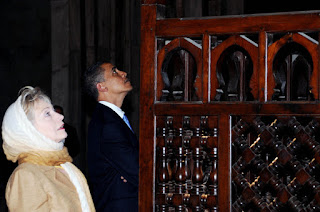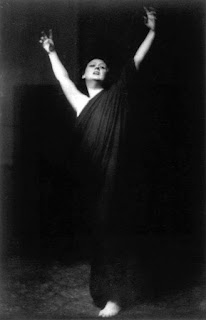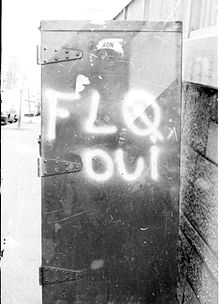
It has become a cliche to cite Winston Churchill's famous wisecrack about Americans, yet one is hard put to find a better explanation of the evolution of US foreign policy in the aftermath of 9/11 than this one-liner often attributed to him: "You can always count on Americans to do the right thing--after exhausting all the alternatives."
This election seems to be proving that statement prophetic, specifically in the aftermath of the terrorist attacks of 9/11. The rise of Donald Trump as well as Bernie Sanders shows that America's response is evolving in a new direction. Basically, each administration has tried a different approach to the problem of Islamic Fundamentalism.
As prior strategy has failed, America has embraced an alternative, in a series of stages: 1. Appeasement under George Bush; 2. Collaboration under Barack Obama; 3. Confrontation under either Donald Trump, via restriction on Muslim immigration, or Bernie Sanders, with the election of an openly Jewish President (perhaps even more objectionable to Islamic fundamentalists).
 STAGE 1: APPEASEMENT
STAGE 1: APPEASEMENT
For whatever reason, while he did topple the Taliban in Afghanistan for harboring Bin Laden (temporarily, without eliminating them, and while permitting Pakistan to keep Bin Laden as prisoner) President George W. Bush also responded to 9/11 by appeasing the Saudis, whose citizens had attacked the World Trade Center with demonstrable help of their diplomatic missions...by removing their greatest foe, Saddam Hussein, covering up evidence of Saudi participation, whisking members of the Bin Laden family out of the United States (who might have been held as hostages in exchange), preventing families from seeking financial compensation, and instituting Islamic law in US-occupied Afghanistan and Iraq, as well as establishing Islamic-friendly policies in US government agencies which led to the elimination of official "Merry Christmas!" greetings and the promotion of US Army Major Nidal Hasan. As a result the rise of Islamic Fundamentalism in the United States is a Bush Administration legacy.
Perhaps the President's thinking had been this could buy time for fracking to kick in and free America from Saudi influence, much as Stalinists subsequently justified the Molotov-Ribbentrop Pact (or as some apologists may have done for the Munich Pact) as a way to buy time to build up armed forces before World War II.
Or, perhaps Bush wanted to demonstrate to "the Arab Street" that America was not anti-Islamic. Bush openly prioritized winning "Hearts and Minds," although this very strategy failed dramatically in Vietnam, rather than unconditional surrender (Saddam Hussein was caught, and executed, but he never actually surrendered or pledged loyalty to the occupation government).
Promoting democracy is usually an easy sell to the American public, and since the Arab masses wanted an Islamic state, the move could have been undertaken as straddle to the obvious conflict between the principles of the Islamic world and those the West. By rejecting a clear provocation to engage in a "Clash of Civilizations," perhaps the Bush administration thought it had "ducked a bullet" in the way Bush himself ducked the shoe thrown at him by an Arab protester during a press conference. Nevertheless, despite eight years of war and trillions of dollars in expenditures, Bush administration policies clearly failed to defeat Al Quaeda, and the "Global War on Terrorism" ended with a victory for Terrorism...as well as the election of Barack Hussein Obama as President of the United States.
 STAGE 2: COLLABORATION
STAGE 2: COLLABORATION
However friendly President Bush's policies were to Islamic fundamentalism--including the institution of Islamic Law in American-designed constitutions for Afghanistan and Iraq, and support of Muslim Brotherhood allied organizations around the world as part of "democracy-building," the Bush Administration shrank from overthrowing long-time American allies for the sake of the Muslim Brotherhood. President Obama's "Cairo Speech" of June 4, 2009 signaled a new direction--collaboration with the Muslim Brotherhood and the embrace Islamic Fundamentalism so long as it remained "non-violent." The speech was titled "A New Beginning," and it marked the beginning of American-supported overthrow of secularist governments by Islamists that culminated in the toppling of Hosni Mubarak in Egypt and Muammar Gaddafi in Libya. America had moved from appeasing Islamists, to collaborating in their seizure of power. In his second term, Obama reached out to Shia as well as Sunni fundamentalists, by giving them
de facto (although not
de jure) permission to develop an atomic weapon.
Perhaps the Obama administration felt that Bush simply had not gone far enough, that lingering resentment of the United States and the West in the Islamic world was caused by the "disproportionate" power imbalances, and that "leveling the playing field" between Islam and the West would result in friendlier relations--and an end to Terror. After all, if the Islamic world could see that not only was America not anti-Islamic, but rather pro-Islamic, there would be no reason for terror attacks. Maybe this is one reason for increasing Muslim immigration to Europe and the United States, despite obvious risks. Unfortunately, despite active American support for Muslim Brotherhood groups around the world, terror attacks continued against the West--in Boston, in San Bernadino, in Paris, and in Brussels.
Whatever benefits collaboration with Islamic Fundamentalism may have seemed to offer the Obama Administration, as a strategy it was no more successful (arguably even less so) than the Bush administration's appeasement of Islamists. Unfortunately for her campaign, Hillary Clinton cannot credibly distance herself from an administration in which she served as Secretary of State.
STAGE 3: CONFRONTATION
Many have noted similarities between the appeal of Bernie Sanders and Donald Trump. Despite ideological differences--Sanders is a socialist, Trump a capitalist--both candidates appeal to outsiders and deliver passionately "anti-Establishment" and nationalistic stump speeches. And, when it comes to Islamic Fundamentalism, both candidates offer a stark contrast to either the Bush or Obama administration foreign policy.
Obviously, both candidates are native New Yorkers. Both have New York accents, both have New York mannerisms, and both publicly express anger in ways common to their birthplace (Russell Shorto has made a persuasive case that New York culture is a legacy of Dutch settlement of New Amsterdam).
Although Sanders is a Vermont resident, parts of that state nowadays seem to resemble the North Bronx of the pre-Robert Moses era, with headquarters for successful companies such as Ben and Jerry's or Green Mountain Coffee, not to mention numerous second homes and hobby farms of affluent New Yorkers, instead of flinty farmers tilling rocky soil.
Sanders has stated that he would "move away from a policy of regime change." That means, by implication, an end to US support for the Muslim Brotherhood. While Sanders does not emphasize his Jewish roots, he does not deny them. Given that Osama Bin Laden targeted New York in part because of its large Jewish population, election of a Jewish President of the United States from New York City would inevitably send a message of defiance to the Islamic world, independent of any particular policy choices made by the candidate.

It goes without saying that Donald Trump's foreign policy views are better known than Sanders'. The outspoken New Yorker has called for a temporary moratorium on Muslim immigration to the United States; he has stated "frankly, we are having problems with Muslims," and he has declared that George Bush failed to keep America safe.
To a successful construction magnate who probably suffers from an "edifice complex," destruction of the World Trade Center in front of his own eyes must have left an indelible mark. There can be no doubt that one of his motivations is to avenge the attacks of 9/11. There can be no question that he would confront ISIS, just as he has promised--it's clearly personal.
There are precedents for dramatic policy swings: The United States dramatically changed policy from collaboration with slavery under President Buchanan in 1860 to confrontation under President Lincoln in 1861--going from fighting, trying, and executing John Brown for attempting to free slaves at Harper's Ferry to invading the South with the Union Army singing the "Battle Hymn of the Republic" to the tune of "John Brown's Body" in order to end slavery in the United States of America.
On a smaller scale, President Reagan's election ended the "malaise" of the Carter years, vis-a-vis the Soviet Union.
Likewise, election of either Bernie Sanders or Donald Trump promises to bring dramatic change of direction to American foreign and domestic policy.
Thus, 2016 has already proven to be a watershed election year.

















